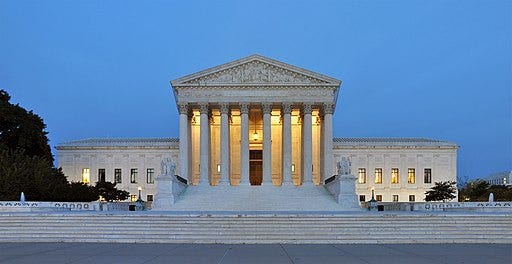SCOTUS' Lesson on the Constitution and Authority, Part 1
The OSHA vaccine mandate has been struck down—what it means and why it matters

The American people, and the multitudinous corporations and entities with whom they work are still unpacking the Supreme Court of the United States’ decision to block the Biden OSHA vaccine mandates for businesses with 100 or more employees. There is much there to unpack, and as more lower court decisions in opposition to vaccine mandates wend their way through, things may not shake out the way people expect.
Essentially, SCOTUS kicked the decision-making on whether vaccines should be mandated back to individual businesses and the local and state entities.
Companies like Siemens, Siemens Healthineers, Verizon, Honeywell, IBM, Aquent, and others I have mentioned in relation to this OSHA mandate simply saw a way to be covered from liability, and used the federal government as their shield. Many of these companies began taking measures to institute corporate vaccine mandates weeks before Biden announced the OSHA mandate on September 9, 2022.
So now corporations cannot say, “The devil made me do it. It’s federal law, deal with it.” However, they can still maintain their mandates or continue to create their own protocols to supposedly combat COVID and its many variants. From this point on, it will all depend upon their level of tolerance for lawsuits, and the bad public relations that comes along with being quislings. There are also shareholders and boards of directors that may also weigh in on how much the so-called worker safety outweighs lost revenue and reputation.
Time will tell.
But here’s what the ruling has assured. In terms of the federal government using OSHA to mandate that large corporations must have their entire workforce vaccinated, SCOTUS has given a hard, “NO.” Alluding to separation of powers, along with the lack of precedent for such an act, SCOTUS basically said that OSHA needs to stay in their lane. It is the job of representatives elected by the people to decide whether there is a need to actually mandate vaccines and if so to then craft the mandates into bill language. Then it must go through the legislative process outlined in our Constitution of committees and then voting it into law, if such a thing is to be federally enshrined.
An unelected bureaucratic body like OSHA has not, and should not be tasked with such a consequential stipulation that would affect millions of lives (estimated at 84 million by the plaintiffs) in and outside of the workplace.
As the SCOTUS opinion pointed out, most of the Senate opposes a sweeping federal vaccine mandate, and 27 States have filed injunctions against this OSHA mandate. That tells you that many of our elected officials have no stomach for it, even though we have an addled president and administration that is slathering after it.
Bottom line: a sweeping, nationwide vaccine mandate is not the purview of a federal agency that is tasked with workplace safety and not with public health. Period.
The opinion was unsigned, with Justices Neil Gorsuch, Clarence Thomas, and Samuel Alito writing a concurring opinion. Surprising no one, Justices Stephen Breyer, Elena Kagan, and Sonia Sotomayor dissented.
I worked in law firms for over 20 years as a document and software analyst and trainer, so I saw the ins and outs of all types of briefs and opinions. When they were well written, it was like seeing a genius’ mind at work. When they were not, well…
The opinion from the affirming Justices, and particularly the concurrence from Gorsuch, Thomas, and Alito was elegant and beautifully written. If like me you geek out on this type of thing, I have linked the entire opinion—feel free to give it a read.
In my next article, I’ll point out and analyze some of my favorite bon mots from the opinion, as well as the dissent.


